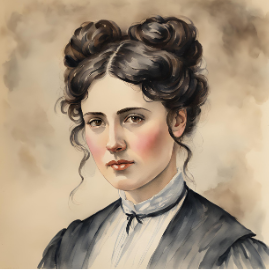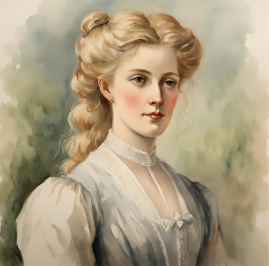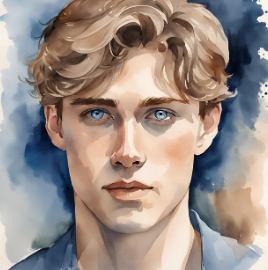Part 3 of Book Analysis: The Awakening by Kate Chopin
Kate Chopin’s The Awakening is a masterclass in creating complex, multi-dimensional characters. Each plays a crucial role in driving the plot, exploring the themes, and weaving the novel’s rich symbolism. Among them, the protagonist, Edna Pontellier, stands out as one of the most fascinating. In many ways, she reminds me of Chopin herself—bold, introspective, and unafraid to question societal norms (a connection I couldn’t help but notice after diving into Chopin’s biography).
But Edna isn’t the only character worth examining. From her distant yet dutiful husband, Léonce, to the enigmatic Robert Lebrun and the contrasting figures of Mademoiselle Reisz and Adele Ratignolle, each character adds depth and meaning to Edna’s journey in the awakening. In this blog, I’ll break down these key characters, exploring their strengths, flaws, and the roles they play in Edna’s awakening. So, let’s dive into the fascinating cast of The Awakening and uncover what makes them so unforgettable!
Key Characters
Protagonist Focus

Edna Pontellier begins The Awakening as the quintessential 19th-century wife and mother—or at least, she’s trying to be. Living in Louisiana’s Creole society, she performs her duties with a sense of obligation rather than joy, always feeling a little out of place. But as the story unfolds, Edna evolves into a fiercely self-aware individual determined to live life on her own terms.
Her transformation begins with small moments: a refusal to host visitors, a newfound passion for painting, and the thrill of swimming for the first time. These seemingly mundane acts symbolize her breaking free from the cage of societal expectations. She begins to see herself not as a wife or mother but as a person with her own desires, dreams, and identity.
As Edna grows, she starts rejecting the conventions that once defined her life. She moves out of her family home, prioritizes her art, and embraces her feelings for Robert Lebrun. While her choices bring a sense of freedom, they also isolate her, revealing the cost of living authentically in a world that values conformity. Edna’s journey is both inspiring and heartbreaking, a reminder that the road to self-discovery is rarely without obstacles.
Secondary Characters
Mademoiselle Reisz

Mademoiselle Reisz is the unapologetic rebel of Creole society, a stark foil to the traditional and nurturing Adele Ratignolle. As an unmarried artist, she lives outside the roles of wife and mother, valuing independence above all else. Her blunt and often harsh demeanor might alienate some, but for Edna, she’s a beacon of inspiration. Mademoiselle Reisz’s life shows Edna what it means to live authentically, free from societal constraints.
Her music plays a crucial role in Edna’s journey. When she performs, it stirs something profound within Edna, awakening her creative spirit and urging her to question the life she’s been leading. More than just a mentor, Mademoiselle Reisz acts as a mirror for Edna, reflecting both the rewards and the isolation of living true to oneself. She’s neither a traditional hero nor a villain but a symbol of the courage—and cost—of pursuing an authentic life.
Adele Ratignolle

Adele Ratignolle is the epitome of 19th-century societal ideals, embodying the “Angel in the House” archetype. Warm, nurturing, and entirely devoted to her husband and children, Adele reflects the rigid norms of Creole culture. She thrives in her role, finding meaning and fulfillment in the duties that Edna finds suffocating.
Despite representing everything Edna wants to escape, Adele is not an adversary. Their friendship is genuine, and Adele truly cares for Edna’s well-being. However, her constant reminders of a woman’s “sacred duties” deepen Edna’s sense of alienation from that role.
Adele is more than just a symbol of societal expectations. Her genuine warmth and belief in the life she leads make her a fully realized character. For Adele, this path isn’t a cage but a choice—one that brings her happiness. Her character highlights the diversity of women’s experiences and underscores Edna’s struggles to find a path that feels true to her own desires.
Robert Lebrun

Robert Lebrun is the charming dreamer who sparks Edna’s awakening. Playful and flirtatious, Robert begins as a harmless romantic figure, but his connection with Edna soon deepens into something transformative. He awakens her passion and her desire for independence, becoming both a catalyst for her self-discovery and a symbol of what she longs for but cannot fully attain.
Robert is one of the most complex characters in The Awakening. While he inspires Edna, his own fears of societal rejection prevent him from fully committing to a life with her. His parting note sums up his internal conflict: “I love you. Good-by—because I love you.” This heartbreaking moment encapsulates his struggle between his feelings for Edna and the societal norms that bind him.
In the end, Robert represents both possibility and limitation. He shows Edna what it feels like to pursue love and freedom. Still, his inability to defy societal expectations reminds her—and the reader—of the constraints that even the boldest desires cannot always overcome.
Relationships
Edna’s relationships with the people closest to her serve as the battleground for her awakening. Her husband, Léonce Pontellier, sees her as an extension of his status, not as an individual with her own desires. To him, Edna is a wife who should manage the household, raise the children, and follow societal norms without question. His lack of emotional connection and inability to understand her needs only deepen her feelings of entrapment, making her yearn for something more.
Her relationship with her children is more complicated. Edna loves them deeply but struggles with the societal expectation that her identity should revolve solely around being a mother. To her, they represent another strand in the web of responsibilities that keep her from living authentically. This conflict adds to her internal struggle, forcing her to question the life she’s expected to lead.
Then there’s Robert Lebrun, the charming dreamer who brings joy, longing, and heartbreak into Edna’s life. Through Robert, Edna experiences a passion she has never known, but his reluctance to defy societal expectations prevents their relationship from becoming what she envisions. His eventual departure—leaving behind a note that says, “I love you. Good-by—because I love you”—is a crushing blow for Edna. It underscores the impossibility of reconciling her desires with the reality of her world. I mean, why Edna falls for someone like Robert is a bit puzzling, but hey, love isn’t always logical. His actions, while frustrating, are pivotal to the plot, showing that even love cannot provide the freedom Edna seeks.
Each of these relationships shapes Edna’s choices, pushing her further away from the roles society expects her to play and closer to the person she wants to become. These connections—full of love, frustration, and unmet desires—make Edna’s journey both poignant and deeply relatable.
Strengths and Flaws
Edna Pontellier is nothing if not complex. She’s bold enough to ask the questions many wouldn’t dare: “What about my happiness? My dreams?” Her courage to challenge societal norms is admirable, especially in a world where stepping out of line could cost a woman everything. Edna’s strengths lie in her determination to live authentically, whether that means pursuing her art, moving out of her family home, or embracing her feelings for Robert.
But her flaws are just as pronounced. In her quest for freedom, Edna often overlooks how her choices impact those around her, particularly her children. She’s willing to risk isolation and judgment, but this sometimes reads as selfishness rather than liberation. Her inability—or unwillingness—to find a middle ground between duty and desire makes her journey as heartbreaking as it is inspiring.
Her husband, Léonce Pontellier, is a study in contradictions. His strength lies in his sense of responsibility; he provides financial stability and takes his role as a husband and father seriously. However, his flaw is his inability to see Edna as an individual with her own desires. He views her as a possession, an extension of his social status, rather than a partner. His lack of emotional depth and understanding contributes significantly to Edna’s feelings of entrapment.
Robert Lebrun, on the other hand, offers Edna emotional connection and inspiration. His greatest strength is his ability to awaken Edna’s passion and make her question the constraints of her life. Yet, his flaw lies in his inability to follow through. Robert is constrained by societal norms, and while he ignites Edna’s dreams, he lacks the courage to defy tradition and fully embrace a life with her. His departure leaves Edna devastated, highlighting the limits of his love and his fear of breaking free from convention.
Edna’s strength lies in her honesty with herself, but her downfall is her inability to reconcile her newfound independence with the realities of her world. Similarly, his rigidity undermines Léonce’s strength in providing stability, and his hesitation overshadows Robert’s ability to inspire. Together, their strengths and flaws create a poignant, interwoven dynamic that underscores the novel’s central theme: the pursuit of freedom is rarely clean or easy; it’s a journey filled with triumphs, mistakes, and hard choices.
Key Moments
Certain scenes in The Awakening beautifully capture Edna’s transformation, and one of the most striking is her first swim. Overcoming her earlier fear of the water, Edna takes to the sea, and it becomes a moment of triumph and self-discovery. “A feeling of exultation overtook her as if some power of significant import had been given her soul,” Chopin writes. It’s not just about learning to swim—it’s about realizing that she’s capable of more than she ever thought possible. This scene is a vivid metaphor for her awakening as she begins to test the boundaries of her world.
Equally unforgettable is the novel’s haunting conclusion. Edna returns to the sea, the same place where she first tasted freedom, but this time with a deeper sense of the stakes. As she walks into the water, she confronts the ultimate question: Can she truly escape the confines of society, or are they inescapable? The ending leaves readers with a mix of resolution and ambiguity, challenging us to interpret the meaning of her final act.
Do I think Edna’s choice was the right one? Honestly, no. But I say that from the perspective of someone living in a modern world where women have far more freedom than they did in Edna’s time. Her choice may feel extreme, but it reflects the crushing weight of societal expectations for women of her era.
Kate Chopin’s gift for creating such complex characters lies in her ability to make them feel both realistic and deeply emotional. Her writing strikes a balance between realism and Romanticism, giving readers a vivid sense of how women lived and thought during this time. The key moments in Edna’s journey don’t just tell a story—they invite us to reflect on the beauty, pain, and complexity of seeking independence in a world resistant to change.